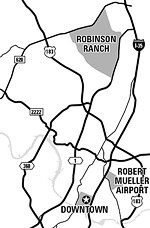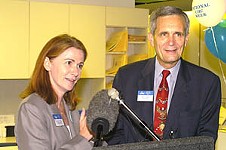Hospital District Campaign Ready to Roll
Backers and opponents gear up for a May 15 vote on a Travis Co. health care taxing district
By Amy Smith, Fri., March 12, 2004
As it was with ACC's successful referendum last spring, the operative word here is "tax" – the necessary evil that would generate an extra $5 million to help shore up a local health system hobbled by skyrocketing insurance rates, overcrowded emergency rooms, and thousands of uninsured residents. That $5 million – to be generated by a tax hike for county residents outside the Austin city limits – is a fraction of what experts say is truly needed to stabilize the local public health system, but it's a start. Right now, county residents pay 1.3 cents (per $100 valuation) of their property taxes toward the public health care system, but Austin residents pay an additional 4.7 cents, via their city property taxes. The district plan calls for all county residents to pay the same rate that city residents pay now; that rate would be capped in the future at 25 cents per $100.
Since introducing the plan more than a year ago, proponents of the measure have switched from using their preferred name, "health care district," to the legal name, "hospital district," to correspond with the language in the state statute. But no matter what it's called, the very idea has stirred the anti-tax crowd into organizing under the name Save Our Taxpayers, which founder Don Zimmerman says is somewhat of a nod to the Save Our Springs Alliance. Taxpayers, he asserts, are as much in jeopardy as the Barton Springs salamander. That's where the similarities end.
Opponents of the district – including Travis Co. Commissioner Gerald Daugherty – cite a number of concerns with the proposal, beginning with the election date. Daugherty and others are dismayed that the ballot issue will go to voters in May rather than in November, when the turnout will be substantially higher. But Clarke Heidrick, who chairs a steering committee that is promoting the hospital district, says the more competitive races on the November ballot would drown the proposal out. Plus, he says, a November election would delay implementation of the district until fiscal year 2006.
The foes aren't buying those arguments. "I think these guys are deliberately pushing for a May election in anticipation of a low voter turnout," said Zimmerman, an IBM software engineer who calls himself a Ron Paul Republican, after the U.S. congressman who crusades against taxes in favor of free enterprise and personal liberties. "The lower the turnout," Zimmerman says, "the higher the special-interest vote."
Daugherty is also unhappy that some key provisions in the original bill taken to the Legislature last spring to create the district were eliminated in the last-minute maneuvering to pass the measure. One in particular would have allowed voters to decide either to continue or to dissolve the district after several years. Without that mechanism, he says, "it's just too damn difficult to change something that's already been created."
Daugherty suggests he won't be a leader of the opposition in this fight – unlike his role in shooting down Capital Metro's light rail plans in 2000. "I'm not overly happy about this [hospital district], but am I as crazy about it as I was about light rail? Probably not," he said. In place of taxes, Daugherty said, he'd prefer the city and county look elsewhere – anywhere – to try and drum up funding for health care and ultimately draw the line on what governing entities can and cannot afford. "Otherwise," he said, "we'll just tax ourselves into oblivion."
Proponents of the district argue that the proposal, with its 25-cent rate cap, offers a "tax-efficient" approach to tackling the problem. (Other Texas hospital districts can levy up to 75 cents.)
Heidrick also points out that the hospital district would not only help pay for health care for the indigent but also for those who are gainfully employed but can't afford insurance. In all, 25% of Travis Co. residents are uninsured. "That's a terrible number," Heidrick said. "That's telling you that there are people out there like you or me who can't afford to pay $7,500 a year for an insurance plan." Moreover, the district would also help Brackenridge Hospital continue serving as the regional trauma center for 11 counties, even though the city-owned facility is squeezed for space that won't become available until 2007, when the Children's Hospital moves to its new site at the old Robert Mueller Airport.
So far, the health district campaign has raised $300,000 toward its $500,000 goal. The measure has broad bipartisan support, including endorsements so far from the Travis Co. Medical Society, the Gray Panthers, and the Austin Council of PTAs, plus the backing of the two major private hospital chains – St. David's HealthCare Partnership and the Seton Healthcare Network – as well as a number of private corporations and banking concerns. By comparison, says Zimmerman of SOT, "We'll be lucky if we can raise $50,000."
The District Details
THE NEED
WHAT WE PAY
HOW THE DISTRICT WOULD WORK
Source: Travis Co. Hospital District Steering Committee
Aguments for and against the hospital district can be found online at www.healthytraviscounty.com and www.saveourtaxpayers.com.
Got something to say on the subject? Send a letter to the editor.










